Mud
February 28, 2011
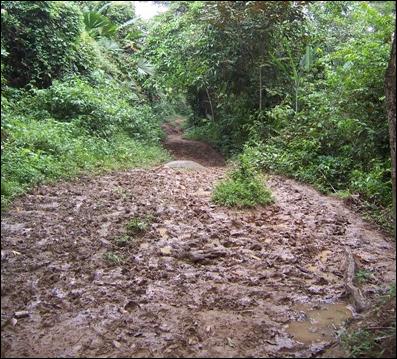
Mud is a reality on most of the farms I’ve ever visited, including ours. Whether that’s seasonally or year-round, in some spots or everywhere, ankle-deep or axle-deep, mud is a factor to be considered in virtually everyone’s farm planning at some point. We’re no different here. Mud has been, and continues to be, one of the realities for on-farm design, management, health care and chore efficiency. The bad news is, mud can appear in the most amazing places, and some would argue its presence is inevitable. The good news is, mud can be predicted, studied and minimized. If we take the time and make the effort to do so.
One fierce combatant of mud, a gal by the name of Alayne Blickle, began as a horse owner who was battling mud on her own property. Instead of merely throwing up her hands in resignation, she began to study how mud occurs on the farm, how best to combat it, and how best to design facilities to avoid it altogether. Her work over the last 10+ years has evolved into a website called Horses For Clean Water, where she shares not only everything she’s learned in that time, but also workshops, downloads and blog updates for ongoing mud control work. The things she’s learned apply to all livestock operations, not just horse properties. We have attended several workshops either hosted directly or indirectly by her group, and have learned not only about mud control but also how layout can impact chores efficiency, how pasture management can impact animal health, financial returns and property value, and how new properties can design to minimize mud, or existing properties can tweak their infrastructure to minimize or eliminate mud.
So, how do we go from being a mud-pit to being a beautiful dry firm-footing farm? There are a number of ways, many of which are either no-cost or low-cost to install or provide. Alayne speaks of mud as being an acronym for Manure, Urine and Dirt. While mud can form simply from dirt and rainwater, mud on farms is often a combination of those three. So separating those three is a key ingredient to controlling mud. Here are some of her recommendations for keeping these ingredients separated so they never combine to form mud:
1) put rain gutters on all roofs, even outbuilding and barn roofs, and then channel the runoff away from those buildings. Those roofs collect a tremendous amount of rainwater, then concentrate that rainwater right where people and animals tend to walk - the periphery of buildings. The larger the roof, the more pronounced the problem without raingutters, and the greater the benefit once they’re installed. This can also have unexpected benefits to nearby areas that typically pond, or are slow to dry out. All that water has to go somewhere, and may times it ends up in the paddocks and yards immediately adjacent to our barns and outbuildings. But when it’s collected and channeled away, those yards stay drier.
2) put down landscape fabric, then footing, in heavily traveled walkways, driveways, aisles and runways. The landscape fabric ensures that the dirt already there stays there. Rainwater can still soak through the landscaping fabric, so it won’t pond. The footing raises the vehicle tires, people feet and animal feet above the dirt and the water level even during downpour events. Dirt stays where it belongs, rainwater either moves down or sideways without making contact with feet, boots or tires, and everyone stays cleaner.
3) Designate sacrificial areas for livestock, separate from larger pens and pastures, where animals can be moved during short-term bad weather events. Those smaller areas can then receive the better drainage and footing materials, at much lower cost than doing the whole farm. Bringing the animals into those areas during bad weather events can also help ensure the animals are not out on pasture when storm activity can knock down fences and allow escapes. If areas have a traditional “wet season” or “rainy season” like we do in the winter, then seasonal housing with better footing, drainage, and raingutters can be a good investment.
4) Locate barns, outbuildings and pastures such that water naturally moves away from areas where animals gather. Also locate barns, outbuildings and pastures sufficiently far enough away from ponds, streams and other water sources that those water sources don’t receive that runoff.
5) Set up a manure storage area where those wastes can be constructively composted, rather than merely dumped out of sight and out of mind. That’s a tremendous resource which can either be used on-farm or sold as a product to nearby farmers and/or gardeners. Setting up compost piles, with adequate air for aerobic digestion and protection from rain, can turn a polluting waste product into an income stream.
6) Fence out streams, ponds and springs so that animals don’t trample down the embankments and shorelines. That will also protect water quality. An old farmer’s story says that two pigs can convert a 1 acre pond that’s 10’ deep, into a 10 acre pond that’s one foot deep, in the space of a summer. Any hoofed stock can do similar damage. If those water features are also water sources, consider fencing out most of the area but putting down firm footing in chosen locations to allow for, yet control, animal access.
7) Put bridges over any low-lying areas in walkways, aisles and runways. Not only will that keep everyone’s feet dry, but it will accomplish much the same benefits as the item above.
We have put most of these steps into effect here, in some way shape or form. Those features that we haven’t done yet, we plan to install as soon as we can manage. The difference has already been incredible. Winter housing for our animals has reduced knee-deep mud in some pens to coronet-band deep mud, or no mud at all. That makes for cleaner, happier, healthier animals. It also makes for better working conditions for me. Given that farm chores take a good chunk of each day, that time savings can make a big difference. But we’re not done yet. We have not yet finished the driveway and parking area. That area is not only large but it is also central to the farm. So we have to walk through it to get from Point A to Point B, and anytime we get into our out of our vehicles. So that’s the next item on our list. Additionally we need to put some small bridges across a low spot on our land that runs right through several yards, and which is crossed by no fewer than four aisles. That low spot often fills with water during the winter, and slows down chores every single time.
Most farms assume mud is a fact of life. It doesn’t need to be. Nor does it need to be expensive. We’ve managed to find most of the materials we need, including the landscape fabric, for free, by working with other folks who need to dispose of suitable materials. That has saved us a lot of money and made a lot of our efforts possible. It also meant putting roofs over animals that some folks would argue don’t need roofs, like our cows and horses. But if I’m feeding and cleaning them twice a day, that roof not only keeps them drier but keeps my chores list shorter. Mud control sounds like a fantasy but it can be as simple as figuring out a farm’s weak points and fixing them. Small changes can make big differences. Mud is one farm feature I sure won’t miss.
Pacing Ourselves
February 26, 2011

This time of year is chock full of plans. Plans for the livestock, plans for the fields, plans for the fences and outbuildings and house and woods. Plans are aplenty but alas, time is already short.
The question of putting those farm plans into effect is always an issue of juggling multiple things at once. There’s the ongoing care required for whatever is already on the farm, whether it’s alive or merely infrastructure. There’s the product commitments we’ve made, whether that’s produce for market, young breeding stock ready for new homes, value added products ready to be made, packaged and sold, or written materials for workshops and publications. Add in unanticipated developments like our work with Pamuk, detailed in our previous blog entry, and suddenly life gets real busy. Adding any new plans above and beyond the current issues and unexpected developments very quickly becomes a tricky prospect.
Some times we just have to stand back and say nope, we’re not going to be able to do that. I’ve started to say that more and more often lately. Some times we also have to acknowledge that while our goals are worthy, our ability to meet those goals are somewhat lacking. We want to do all the work ourselves, but there’s not enough time in the day, let alone enough energy in the body, patience in the soul or alertness for the mind. We need to ask for help, or hold off working on some fraction of those projects. That somehow comes hard to folks in the farming profession, perhaps because we tend to be rather independent in nature. We built this place with our own hands by golly, and we don’t need or want anyone’s help to continue that work. Sometimes that attitude costs us, either in the form of delays, or projects left hanging because we don’t have the umph to finish, or worse - a breakdown of our health because we pushed too hard. I see a whole lotta people accomplish admirable things only to break down later. I have to ask myself whether they could have accomplished more over time, by easing up on their drive to accomplish so much so soon. Or perhaps they just spread their net a little too large and tried to cover too much. Then when it came time to harvest all that volume, they just didn’t have the wherewithal to succeed.
I had a telling conversation with one of my mentors the other day along these lines. I had seen an email go through one of our local sustainable ag lists, asking for support for an urban farming project. That email didn’t get much in the way of a lively response, which surprised me. Surely sustainable ag includes urban farming?!? So I asked my mentor, who also saw the email, why there had been so little response and enthusiasm from the group. After all, surely there were some shared goals here. She explained that during the last few years, that particular sustainable ag group had been “too successful”. So successful that they had been inundated with calls and emails from hundreds of local groups, some with close ties to sustainable ag, and some whose connection was indirect or tenuous at best. All of those calls and emails wanted fundamentally the same thing - support. Whether it was financial support, manpower support, planning and logistical support or legislative support, they wanted time, money and/or energy from the people in the group. And that time, money and energy was already in short supply. After a variety of previous experiences with providing that support, the group finally decided that they could not “be everything to everyone”. They could only provide X amount of support at any given time, and they needed to concentrate that support on those core issues that they held most dear. Her explanation rang true, but was still difficult to hear. Apparently even good deeds and good-deed-doer’s have their boundaries.
So this year, for the first time, our plans have deliberately been scaled back. We want to be in this for the long haul, and that means we have to pace ourselves. Determining how much progress is sufficient, versus too much, is a tricky business. We’ve settled (for the moment) on progress that can be accomplished a) without cutting into time/money/energy already allotted to maintain what we already have, and b) will further our goals to create a sustainable farm with a sustainable income, in environmentallly, ethically and economically sustainable ways. That’s quite a mouthful to say and even more of a challenge to plan. But it’s the best compromise we’ve found so far. The best pace for moving forward without going so fast we crash. We want to be here farming in 10 years, not burned out and moved back into town with bitter memories. So if it takes a bit longer to accomplish, well, perhaps that’s OK. Like my mentor explained, we need to stay true to our pupose, not try to be everything to everyone, and not spread ourselves too thin. A hard lesson, but a crucial one.
Pamuk
February 24, 2011
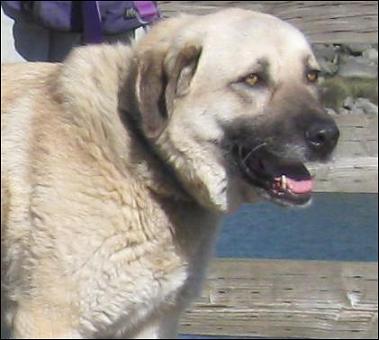
This month has been busier than usual (and February is the start of the busy season around here), because of a new project. We have agreed to once again take in an Anatolian Shepherd dog as part of our work with the National Anatolian Shepherd Rescue Network (NASRN). It’s a huge responsibility, not merely because of the size of the dog, but also because of the size of the commitment.
We got started with Anatolians as livestock guardian dogs back in 2007 with the arrival of a 10 year old Anatolian rescue, named Sam. He had been a guardian dog on another farm for his whole life, and a member of that farm’s family, until that farmer decided to retire and sold all his livestock. To that farmer’s credit, Sam was not dumped at the shelter but rather was given to a nearby sheep farmer who wanted a livestock guardian dog to protect his flock. Unfortunately for Sam, that flock was not near the house as had been the case at his previous home. Instead, it was parked out in a remote area. Sam went from having frequent, long-term human interaction as a member of the family, to having none at all. We don’t know much about his time at the sheep farm but apparently that sheep owner didn’t like Sam’s initial performance of his duties. After only three weeks, Sam was dumped at the shelter. That’s when the NASRN got involved. One of the NASRN volunteers pulled him from the shelter and placed him with a foster home, where his personality, skills and health could be assessed. Once that information was available, and he was determined to be a good adoption candidate, he was put up for adoption. While all that was happening, we had also contacted the NASRN to get more information about how to get started with livestock guardian dogs. We had goats, rabbits and chickens at the time, we could offer a family environment, stout fencing, daily interactions, and a fairly relaxed atmosphere. The good folks at the NASRN determined that Sam would be a good match for our needs, and we were willing to do the required work with him to ensure that we meet his needs as well. That adoption took place in July 2007.
Since then, we have adopted three other Anatolians. A whole book worth of information wouldn’t be sufficient to describe the adventures, the lessons, the work we’ve done and the work they’ve done, since they’ve each arrived here. Suffice to say we have grown to love and respect these dogs beyond any ability to express or measure. So when we learned earlier this month of an Anatolian named Pamuk at our county shelter, slated for euthanization, we felt compelled to work with her to see if we could get her off death row and at least foster her here.
Pamuk’s story is fairly typical. She had been purchased as a puppy by a man for his family, and for the first five years of her life she had been a welcome part of that family. Then a combination of family upheavals and economic conditions dictated that the owner had to move from their rural property to a small house in town. To his credit he tried to take her to that new home. But a very big dog in a very small yard, with a propensity to bark late at night, was not a good combination. He was forced to take her to the county shelter. One of the sad tendencies for Anatolians is that these proud, confident, self-reliant dogs don’t do well in shelter-type environments. Too much noise, too much activity, too many new faces and new animals is overwhelming for them. Some respond by withdrawing. Some respond by growing belligerent, and some respond with depression. Pamuk’s answer was a combination of assertive and dominant behaviors that took the shelter staff by surprise. Within the space of only a few days, she had exhibited dominant behaviors with enough of the staff that they deemed her too risky for adoption, and had slated her for euthanization. That’s when we got involved.
We have been working with her since the first of the month, using Alpha Dog techniques developed by other dog trainers to simultaneously establish our position as leaders while preserving her sense of pride and dignity. It has been a major upheaval in our work schedules to suddenly spend so much time driving to and from the shelter, and walking her two miles every day in a nearby park. But that’s what it takes to build that trusting, respectful relationship. Meanwhile, we have to build a new yard for her here on the farm, close enough to the other animals that she can see and become a part of what is going on, yet far enough away that she’ll have her privacy and personal space. We estimate another week or so, and we’ll finally be ready to move her home.
These dogs bring so much to the farm, but they require a tremendous amount of careful preparation and groundwork to be good partners. Not because they are stupid or hard to train, but ironically because they are so smart and willing to take over if they perceive a lack of leadership. Pamuk’s progress during these last few weeks has been phenomenal, to be sure. But our work with her is just beginning. We’ll need to continue establishing clear leadership with her, and ensure that any prospective adopter establishes the same. She, in turn, will provide what her breed has been bred for thousands of years to provide - loyal, competent, intelligent protection of farm, livestock and home, against any and all who don’t belong there. Her commitment to that job is absolute, and our commitment to her needs to be as strong. For folks thinking about adopting or buying livestock guardian dogs, we try to impress upon them both the amount of dedication that dog will have for their house and farm, but also the amount of dedication they’ll need to have for the dog, before that relationship can work the way it should. Pamuk is coming along nicely in that regard. We’ll see if any adoptive homes are willing to match that effort.
Land Clearing
February 22, 2011
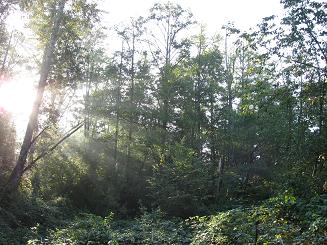
Our farm is not a picturesque assortment of tidy pastures and nearby outbuildings. I’ve already written about how we had no outbuildings when we first arrived, and we are still in the process of putting up new ones. We are also always in the process of clearing land. Our property was originally cleared of its native conifer forest approximately 100 years ago, but then let go to develop brushy pioneer species. In this area, that means alder, big leaf maple, wild cherry, blackberry, salmonberry, and a host of other understory species. By the time we bought our place in 2000, most of our land was so thick with understory growth that we couldn’t walk from one end of it to another. And the alder that had come in after the conifers were taken are nearing the end of their natural lives. With each windstorm, which are plentiful in our area in winter, we have a few more go down. As a result, land clearing for us isn’t simply a way to have more useable ground. It is a way to get access to the land so that we can start to manage it proactively, instead of letting the wind, the rain and the snow dictate which trees come down, in which directions, and then watching the blackberry take over and smother everything. Others in this region who have let their properties go have acres and acres of blackberry to show for that neglect. Ironically, by letting the land go “wild” in that way, we severely restrict which wildlife can then use that land. Anything larger than a raccoon has a very hard time moving through blackberry thickets. And the lack of sunlight reaching the ground means nothing will ever grow there once the blackberries take over. Unless that blackberry is removed, the land becomes almost sterile. But how to proceed?
I worked for a year to clear two small areas near the house, and it was an ongoing project. I’d clear away blackberry vines from a 50’x50’ patch and four weeks later, you’d never know I’d been there. Sadly, they also grew back with more thorns. Few things are as disgusting as clearing land once, then having to go clear it again and have it be twice as prickly in the process. Plus, at that rate I’d never get even a small portion of the total property cleared. I had to do something else.
The year we got goats was the year everything changed. Goats are not grazers like horses, cows and sheep. They are browsers, which means they prefer shrubby and leafy growth rather than grass. They will definitely eat grass, but if given a choice they will snarf down brush like it’s going out of style. And they absolutely adore blackberries. Our first two goats could clear a 50’x50’ area in a few days. It took me longer to build the fence to contain them than it did for them to eat the entire contents of the yard I’d just fenced. We figured we’d found our answer to clearing our land. But the blackberries weren’t so cooperative. After the goats had taken the vines to the ground, a few weeks later the blackberries sent up new vines, and it started all over again. It took the vines longer to come back up from soil-level, but return they did. At that point, a scorched earth policy was starting to look pretty good.
The year we got pigs, that changed again. While goats love above-ground growth, pigs go for either above-ground or below-ground yummies. And it turns out, from a pig’s point of view, blackberry root nodules are yummy. So we turned the goats back into that 50’x50’ yard to clear the top growth, then turned in the pigs to root out the bottom growth. And root it out they did. For the first time in years, we had a yard that was not only free of blackberries for the short term, but looked to stay that way for at least a while. Yet we still weren’t done yet. Nature abhors a vacuum, and eventually something would grow there, whether we planted it or that seed drifted in on its own. So how to prep the land for planting? Once again we turned to critters, but this time it was the cows.
Cows are amazing creatures. They are natural terraformers, if given the proper supplies. By simply feeding them their grass hay on the ground, and then rotating them through various areas, we have been able to lay down a fertile mulch over just-cleared areas such that not only will blackberries not come up immediately, but grasses and forbs will. The combination of waste hay, cow urine and cow mature is a potent mix to create that living mulch, but only if the cows are kept moving and don’t stand around in one area too long. If they do stand around too long, it becomes a mucky muddy mess. But managed even moderately well, cows can remake a landscape.
So now we have multiple yards undergoing conversion at any given time - the goats go in and clear the above-ground brush, the pigs go in and root out the below-ground roots, the cows go in and then do what they do best - eat, poop, pee, and lay around. Slowly but surely, we’re creating those nice pastures which are traditionally associated with tidy small farms. It’s an ongoing process, to be sure, and my time is just as critical along the way. Instead of clearing land, now I’m perennially building more fence and repairing the fences we already have. The land is responding nicely and we finally feel like we’re making progress. Land clearing isn’t for the meek or the shy. But it can be done and done well, in a variety of ways and with a variety of tools. Not everyone wants goats or pigs or cows. For us, they worked extremely well.
You're Doing It Wrong
February 20, 2011

It’s easy to be a naysayer. And I’m as guilty as the next person (maybe even more so) when it comes to talking about yep, this is the right way to do it and nope, that’s the wrong way. And in farming, there’s lots and lots of opportunities to critique someone’s methods. Particularly when someone is trying something new. But the real question is, can we provide useful feedback while also allowing for new approaches?
Case in point. Some friends of ours asked us a few years ago about how to get started with raising a small flock of laying hens. They did not want to sell the eggs; just collect enough each day to meet their own needs. They also knew they would have moderate to intense predator pressures due to their location. They consulted all the books, and built what seemed to them to be a solid little chicken coop that would provide a protected place for the birds to eat, roost and lay eggs. They asked several of us to look over their coop prior to bringing in birds. I couldn’t get out to their place for a few weeks, but I went out as quickly as I could. When I looked at their coop, yes it was very sturdy and would provide a lot of protection from local weather and local predators. But it had nest boxes up pretty high, and roosts down low. With the very best of intentions, I told them that they might want to reverse that layout such that the nest boxes were low and the roosts were high. After all, our chickens always sought out the highest possible roosts, and either used ground-level nest boxes or found some ground-level hiding spot to lay their eggs. What I didn’t realize at the time was that they had originally used a design with just that layout. Unfortunately, another grower had come by and told them that the roosts were too high, and should be lowered, and the nest boxes too low, and should be raised. So they had ripped everything out and started over. Then when I came along and told them nope, it needs to be changed again, they understandably felt irritated and conflicted over which answer was “right”. To my knowledge, they never went forward with their chickens project. Which is a shame, because it’s entirely possible that either design would have worked.
One of my mentors once told me that there are 100 ways to do it wrong, and 100 ways to do it right, whatever “it” happened to be. And what worked on one farm, in one county, in one part of the country, may or may not work elsewhere. She’s not the only one to say such things. At a relatively expensive growers conference I attended awhile back, someone asked about the “best” way to grow spinach, because they’d had several failures with spinach. The presenter laughed and said “ahh, yes, spinach. The very best advice I can give you for growing spinach is that if you ever have success with a certain approach, change that approach as soon as you can. Because every time we think we have figured out how to grow spinach, that second year all our efforts fail. We’ve never succeeded two years in a row.” And he was dead serious. And then there’s the inevitable stories about crops that grow where they shouldn’t, animals that thrive where they shouldn’t, and farms that prosper where they shouldn’t. Clearly, sometimes things can work when they’re not supposed to. And sadly, the opposite is true as well. Crops fail in good ground. Livestock wither and die despite good feed. Farms dry up and blow away on soils that should have been able to carry them for hundreds of years to come. So what are we to do?
One of the best information exchanges I’ve yet found are the various livestock groups available at Yahoo.com. I am a member of at least two dozen agricultural-based groups on Yahoo (plus a few more that aren’t based at Yahoo), with names like HomeDairyGoats, TheSheepGroup, HomesteadHogs, SmallFamilyCow, Self_Sufficient_Farming_And_Living, and others. On those various lists, we talk about every topic under the sun - feed, housing, fencing, farm equipment, prices, practices, health issues, marketing. It is a way for folks to get a tremendous amount of information from a very wide variety of sources. Not sure how to do something? Ask a question, and you’ll get 10 different answers, and a lot of discussion about which solutions work best in which situations. Then you can try out those answers which make sense to you, on a small scale, so you can see what works best on your own farm. But at any given point you’ll also be aware of all sorts of additional options which you can try if those first few plans don’t work out.
At some point the moment comes when we have to finally choose an approach, and go for it. It is very easy to get caught up in concerns that whatever choice we make, will be wrong. I think doing a lot of homework and having a very good idea of the possibilities is an excellent start, but it’s only a start. We must also then be able to make a choice, act on it, then be ready to evaluate how well that choice worked out. If it works out well on a small scale, then we can expand. If it doesn’t, we haven’t lost a lot with the attempt. And when we are asked for our opinion on what will work and what won’t, we have to temper our advice with the knowledge that we haven’t seen it all, tried it all, or done it all. Our efforts may have succeeded or failed, but others will have different experiences and we need to allow for that. Perhaps the best advice we can give would therefore be “try on a small scale, and if that doesn’t work, try again on a small scale, until you find something that works.” And be ready to see other folks succeed with methods that never worked for us. Perhaps that’s the hardest task of all. And in my experience, the very best measure of a true master - someone always willing to learn new things about old, familiar topics.
Useful Weather Forecasting
February 18, 2011

I’ve written before about our reliance upon weather forecasting here, and living the weather, and the implications if we’re not ready for storms. That forecasting is a crucial part of our planning, and sometimes I wonder what we’d do without it. Meteorology has made incredible advances over the last 10 years in radar imagery, advanced-warning storm detection and predictions, and even seasonal trends for temperature and rainfall. Where once we would have been limited to watching the skies and guessing at what that wind change would bring, now we typically have at least several days’ warning for whatever weather is headed our way. My daily schedule is built around that information.
Yet I still hear people talk about how flaky the weather forecasts can be. Ironically, they rely on them far less than we do, yet they complain about them more. When I ask what sources of information they use for those forecasts, many of them refer to the standard local news channel’s weathercasters. To be fair, many television news programs do not employ forecasters with even moderate meteorological training. They merely inherit the forecasts made by others and then provide that information for their viewing audience. They also cover typically large geographical viewing areas, spanning an entire region. For example, our local forecasts run from the oceanside communities of Washington state, all the way to the mountain passes the Cascades. That spans an area roughly 200 miles wide by 400 miles long, with a 5,000’ change in elevation. Network television forecasters have to provide very generalized information for such a large area. As a result, their forecasts are commonly lacking in the detail and accuracy that people want.
A better forecasting method has come courtesy of the Internet, with a range of websites that cater to a person’s particular locale. Public websites such as www.weather.com , www.intellicast.com and NOAA’s National Weather Service website at www.weather.gov all provide a wide range of weather forecast services, along with real-time weather advisories and numerous graphics capacity for things like precipitation, wind, fog, and storm activity. Those sites sometimes carry advertising that can bog down a screen’s loading time, but they also provide valuable information on whatever scale we need, whether that be within a one mile or 1000 mile radius. Websites like these have been our servants for a number of years now, and are amongst the most frequently consulted websites I use on a daily basis. Had our forecasting ability stayed at this level, I would have already been quite pleased with those advances.
Yet forecasting has already taken another several steps beyond even the above websites. We are very fortunate in this region to have the University of Washington’s Atmospheric Sciences department. One of the professors there, Cliff Mass, has a blog which provides a very in-depth look at current and upcoming weather events, plus the forces that shape them and the science that predicts them. His blog entries are therefore one part forecast, one part meteorology class, and one part science ethics and technical communications project. It’s clear from his writing that he doesn’t merely live and teach the weather, he loves it. And he shares his love, and expertise, freely with his blog readers. He has also created an experimental forecasting service called the probcast, which is short for probability forecasting. In that service, the forecast provides not only the predicted high and low temps and likelihood of precipitation, but also the range of conditions possible for any given ZIP code, along with access to the computer modeling maps that generated those numbers. Cliff’s blog is here and his probcast website is here.
Another weather service for our area is the WeatherCafe, hosted by Rufus La Lone, an entomologist-turned-meteorologist who provides twice-weekly long-term forecasts for the Pacific Northwest, with an agricultural focus. While he does not provide the graphics offered by Cliff Mass’ blog, he offers an in-depth look at the coming weather trends, and how those weather patterns will impact agricultural activities. He helps demystify the weather in a very agreeable conversational tone. His twice-weekly forecasts are available here.
For those whose interest in the weather is simply a matter of curiosity, the forecasts provided by network news is perhaps enough. But for those of us whose jobs are determined by, and occur in, the weather, a lot more information is both desirable and available. While these two regional sources of detailed weather information are not suitable for someone in, say, the Midwest, there are undoubtedly similar sources of information available in those areas as well. Weather forecasting is one of the rare disciplines which simultaneously is changing very quickly, and whose changes impact many, if not most of the population at any given time. Whether your interests are professional or merely curiosity, check out these more advanced forecasting services sometime. It might put a bit more sunshine in your day.
Instant Gratification
February 16, 2011
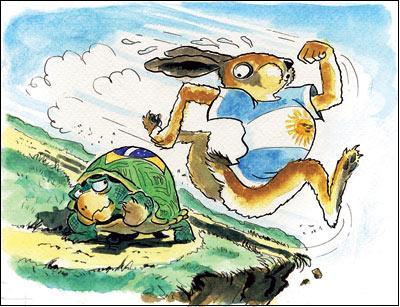
“Order in the next 10 minutes and you’ll also receive………”
Farming is definitely not an instant gratification gig. The tasks we do today won’t pay off typically for at least 90 days, but usually we need quite a bit more time than that when everything is said and done. Our broiler birds only need 8 weeks from the day they hatch until the day they are butchered and sold. But I need to prep their living area, get their feed, brooder, lighting and waterers all set up, and their field pens repaired and deployed, before that hatch date. Either that or I’m playing catch-up for the rest of that 8 week grow-out period. Crops are similar. The fastest marketable plant product I know of are sprouts and baby greens, which can take one week for the former, or three weeks for the latter, between seeding and harvest. Yet the prep work required to prepare for that seeding and harvest is as much work as the actual grow-out period itself. And the faster the product line is ready, the more critical that prep work becomes. If we don’t have everything absolutely in place and ready to go when that seeding date or hatch date or birth date arrives, we run the risk not merely falling behind, but even losing the crop or the animal we were counting on for that income.
I run into folks who look at what we’ve built here, and declare that they’d love to have a place like ours. But they would not have wanted to start with bare ground and spent the last 10 years building each building and laying out each fence line like we have. Sometimes I wish that all the work was done too. But then I’d be in the not-wonderful position of inheriting someone else’s priorities, preferences, methods and biases. The vast majority of the time, I am very pleased to have the luxury of putting a new building exactly where I want it, to the measurements I want, built the way I want, and with the layout I want. It takes longer that way, and it requires time, money and effort that I must justify as being warranted for that project versus something else. But I end up with exactly what I want. If I don’t end up with what I want, I have only myself to blame. And I have the ability to go back and change things without any obligations to preserve what someone else built.
There is also the question of working hourly versus working until the project is done and sold. The vast majority of my friends and family have office jobs, where they show up at a certain time, stay there a certain time, then leave at a certain time. Whether they are spectacularly productive, moderately productive or simply occupying a chair, they get paid the same, and usually get paid within two weeks. Leaving behind that safety net to work for themselves is understandably frightening, because there are no guarantees. When I plant something, there’s no guarantee I’ll successfully be able to harvest anything. When I harvest, there’s no guarantee that I’ll be able to sell it. Much of my planning and prepwork is not to prepare the actual plant or animal, but rather to ensure that I can sell it at a profitable price once I get that far. For some, that is entirely too much uncertainty. So they stay at jobs which require they commute long distances, put in long hours far from home, and perhaps do work they’d rather not be doing.
For folks who dream of breaking out of that cycle and farming for a living, I encourage them to start small. Not only learn the production ropes, but also learn what it takes to work really hard every day, but not see a penny for that effort until weeks or months down the road. And to have some reserves in the bank so that if they don’t make that sale weeks or months from now, they aren’t in serious trouble. Some try it and love the lifestyle and build their operations up in ways that make sense for them, and never look back. Or look back only occasionally. Others try on the lifestyle and decide nope, it doesn’t fit quite the way they’d hoped. Neither outcome is “right”. Both have their place in the world. For those who want to work a day and get paid for that day, right away, perhaps office work really is the best option. On the other hand, for those who reap enjoyment merely from building something from nothing, and can set things up such that the pay today came from the work you did three months ago, and the work you do today will pay you three months from now, it can be a wonderful life. But be warned - the farm life doesn’t readily accommodate the instant gratification fix.
Valentine's Day
February 14, 2011

Valentine’s Day came and went here today with some, but not a lot, of fanfare.
Farm life is in some ways very liberating, because we pick and choose the business activities that we get involved in. But once we make those choices, we are tied to the requirements of those activities regardless of whatever else is going on. In the case of livestock ownership, there are chores to be done, pregnant or young animals to be tended and all sorts of related tasks which don’t give us the day off unless we hire someone to do the work for us. With greenhouses and field crops, those plants have to be watered, weeded, fertilized and other tasks which also sometimes can’t wait. That means holidays come and go and we still have work to do.
Some look at that as a reason to not pursue this life. After all, if an office job can take the day off, but farmers can’t, then the office job would seem the better choice for quality of life reasons alone. Others see farm life as a way to celebrate all of life’s moments in a setting we already enjoy. Holidays on the farm can be as memorable as anywhere else. Some have gone so far as to turn holidays in to a profitable farm enterprise. Others, us included, choose to celebrate holidays quietly, in this place we have hand crafted and brought to life.
Our day today was spent basically the same way most days are spent, with The Husband at his off-farm job and me working here. But about midway through the day, that delivery truck drove up with a gift I get every year but always manage to forget about until it arrives - the bouquet of nice flowers. A gift to put in the windowsill and look at for days to come, to remind us both of this holiday and what it stands for.
Dinner was brief tonight as usual, with chores going until 9pm, bedtime fast approaching, and both of us much too tired from our day to want to go anywhere. And that 5am alarm clock will be going off tomorrow just like any other workday. So our Valentine’s Day evening was spent simply enjoying a quiet evening together, here on our little piece of ground, far from the madding crowds. But we did give ourselves something that we and everyone else we know, never seems to have enough of. Namely, some quality time. I started chores early so I could finish early, and I had done the several-times-a-week tasks earlier so that I wouldn’t have any of them to do tonight. We can’t get away from our daily tasks but we can sometimes juggle things a bit to make room for what matters. So I’ll keep this blog entry short tonight too, all so that we can enjoy the holiday just a little bit more, here on the farm.
It's What's For Doggie & Kitty Dinner
February 12, 2011
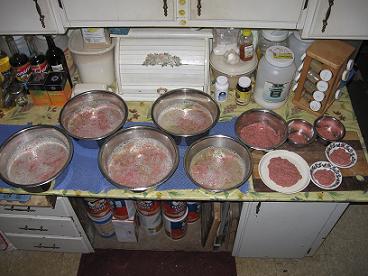
We have five dogs, four of which are actively engaged in providing protection against predators. Our fifth dog is retired and currently guards the couch, but her years of service to our farm and household has paid for that retirement a hundred times over. Given that these animals are a crucial part of our operation, we need to be as careful with their daily management needs as we are with any other livestock on the farm. But let's face it - several hundreds collective pounds worth of canine will go through its share of the grocery bill in a hurry. Our barn cats are also considered mission-critical staff, because they keep the rodent population down. Having lived through The Year of the Rat when that rodent population was out of control here, I have no illusions what life without our cat staff would look like. Now, seven felines don't go through the groceries as fast as five big canines, but they do their fair share of damage. So, how do we provide top notch nutrition to our farm employees in a cost effective manner? We feed them a raw diet, and we are working on growing as many components as possible of that diet, right here on-farm.
So what's the big deal about raw diets? "That 50lb bag of kibble in the cupboard has served us well, it's cheap to buy, and it's easy to serve." Yes, it is cheap to buy and convenient to use, and those should be your first big red flags that something is amiss. Think about our own foods, and how fresh, raw foods have all their nutrients intact. Yet the more processing you do to foods, the fewer nutrients are preserved. Human nutritionists have railed for years against the dangers present in a highly processed diet - empty calories and hyped up kids with reduced ability to concentrate at school. Or adults that roll out the door each morning with a cup of coffee in their hand which is supposed to last them until they can get to the donut box at work, which in turn is supposed to last them until they go grab lunch at some greasy spoon. Then around 3pm, their energy levels and concentration both sag, and they reach for that soda or energy drink to get them through the rest of the day. And on the way home they have an appointment with their doctor to discuss the ulcers, headaches, high blood pressure, and other health issues that seem to dog their footsteps. This isn't rocket science, Dear Reader. We do this to ourselves with the food choices we make. Sadly, our dogs and cats don't have choices about what they eat. They have to eat whatever we give them. And they suffer similar health issues when their entire diet comes out of a highly processed bag of kibble. Pet obesity, joint deterioration, "hot spots" on the skin, digestive ulcers, hair loss, fleas and even cancer or kidney failure all have at least some basis in the foods they're fed. Switch those less-than-healthy animals over to a more appropriate species diet, and many of those health issues are either minimized or reversed outright. Start animals with a healthy raw diet and keep them there, and those health issues will often never materialize.
"But raw diets are messy, and expensive, and time consuming!" Well, I guess it depends on your perspective. Feeding animals a raw diet is no messier than feeding ourselves a home-made meal. Yes, if this is the first time you've ever cooked or prepped a salad, it's going to be unorganized as you sort out how best to use all the ingredients. But make that same salad or that same casserole 100 times, and you'll figure out how to go faster, with less mess and less waste. The same is true for feeding animals a raw diet. As for expense, it is an illusion that kibble is cheaper than raw food. When you feed an animal the same kibble day after day, which is formulated to be cheap and convenient, that might not cost you much up front. But those costs will start to show up later in the form of increased vet bills and prescription drug costs, or expensive supplementation that should have been in the foods to begin with. That animal's body is literally starving for the correctly nutrients, in the correct form and in the correct ratios, and that kibble generally doesn't have it. So eventually you'll have to pay for health issues that are nothing more than the result of nutritional deficiency. As the saying goes, an ounce of prevention is worth a pound of cure. Feeding raw diets every day may be nickels or dimes more than kibble, but your cost savings will be the lack of vet bills you'll have down the road.
"Ok, so how do I get started feeding a raw diet?" You have a variety of options, Dear Reader. One is to check out a variety of the raw-diet websites which go into great detail about how to switch over your cats and/or dogs to this feeding approach. Here are a few of the better websites I've found for that purpose:
Wikipedia's page on raw diets and feeding
DogAware page on homemade diets
Third, Yahoo Groups feature a number of raw diet forums where you can post questions, get answers, and swap information amongst other cat and dog owners. One of the very biggest is RawFeeding, which has 20,000 members. That parent group has been so successful, it has spawned a number of smaller, more focused groups to discuss particular aspects of raw feeding - topics for breeders, vets and researchers, retailers, etc. In addition to the extensive conversations going on at any given time, those groups have a wide variety of files available in the Files section of the Group page, which are all available to members. You'll get more information there than you'd ever get from any of the websites or books listed, but it won't be as well organized and you might have to dig to find some of the answers.
We switched our animals over to a raw diet many years ago, and we've never looked back. Yes it's a bit more work for us in the evenings, but the payoff has been working partners who live to extreme senior citizen status yet enjoy good health for the vast majority of that time. Our retired dog is 15 years old and the only reason she's retired is because she's gone deaf. But she's still as mobile and alert as the others, despite her age. Our cats regularly live to be in the late teens. So there is a payoff to the effort. If nothing else, experiment with a raw diet for awhile and see how it goes. There's no need to dive in and convert 100% of the diet all at once. Alternate nights or provide a half-and-half diet for awhile. Whatever it takes. Your canine and feline friends will thank you.
Manual Labor
February 10, 2011
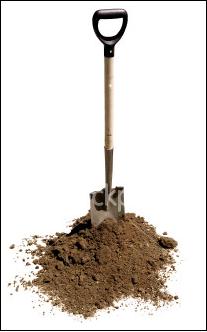
My partner and I have been digging in her greenhouse for the last several working sessions. The greenhouse is new and built over generally fertile but unworked land. We’re reshaping that unturned ground inside to create four raised planting beds. The beds are each 3’ wide and run the length of the greenhouse. As we level out each walkway and form each bed, we then frame the bed with heavy cedar planks from a local mill. The finished beds will be fantastic additions to the greenhouse: providing relatively warm and well-drained soil and wide, level, clearly defined walkways. Additionally, the raised bed frames will provide leveled work surfaces will serve double duty as work platforms for early in the season. We’ll be able to start thousands of seedlings inside that warm dry environment, then move them outside as the weather warms up. Once the seedlings have moved outside, those planting beds will then be ready for planting themselves.
It’s been relatively easy going, with smooth soil and few stones to slow our progress. But it’s been work, no two ways about that. To create the good working environment and level planting area, we’ve had to manually dig out those areas above grade, back-fill and rake smooth those areas below grade, and cart the excess soil to another part of the farm. Even that excess soil has a purpose. We’ve been using it to create a small raised area that can provide dry ground for equipment and animals during soggy weather. Even a small pad only 1’ above grade can be enough to provide her animals with dry footing during the worst of our winters. But creating that pad has meant moving wagon-full after wagon-full of heavy clay soil up the hill to the new spot. Neither of us has a tractor and we did not want to rent one, which would only have filled the inside of that wonderful greenhouse with exhaust fumes. Besides, the inside dimensions of the greenhouse would have made maneuvering even a small tractor challenging at best. So, we used shovels to fill one wagon-load at a time, then used the lawn tractor to pull the wagon uphill. Slow, but steady progress. I get home very thoroughly worn out.
Many, if not most, of our friends and family would think this was a terrible way to spend the day. Invite someone to join you for a day of dirt, sweat, work gloves, mud boots and manual labor, and they’ll look at you like you’re crazy. “My gosh, that’s such hard work! And you get so dirty! And you don’t get to sit down! I went to school just so I wouldn’t have to work that way!” I suppose it’s a much more appealing idea to work at comfortable desks, inside comfortable offices, making decisions and participating in meetings to further the goals of whatever company they work for. And in some ways, that sounds more attractive to me too. But there’s a tradeoff. Their bodies haven’t been moving all day, so they feel physically stiff and restless at the end of the day even though their minds are tired. They need to go work out at the gym (there’s that dirt and sweat again, camouflaged in spandex and tank tops), then eat their reduced-calorie dinners to maintain their target weight. Or if that doesn’t sound appealing either, they go home, maybe walk the dog or chase the kids around, get dinner going, watch some TV and then fall into bed mentally exhausted, but with another surplus of calories to add a little more to the waistline. The progress they made during the day was often only measured in terms of meetings attended, work packages released, and other paper-trail signs of progress. Their very goals, tasks and methods were chosen by others higher on the chain of command, or higher in the management tree. And the fruits of that labor will be distributed amongst hundreds, if not thousands, of co-workers.
Farming is regarded as “dirty, hard work” and thus frowned upon by many in our society. But our society’s sedentary lifestyle is strongly associated with the diseases which most often kill us before our time - heart disease, diabetes, stroke and other obesity-related health issues. I suspect if we were a little less afraid to get our hands dirty in good healthy soil, and work up a good sweat outside on a regular basis, and a little more resistant to the siren call of the couch and home theater system, we’d be a much healthier population. I know I’m in the minority with that opinion. But I am as fit now as when I was 25 years old, as demonstrated by my continued excellent health checkups. A nation of folks who got off the couch and got back outside, working in their yards and gardens and even balconies, moving dirt and planting seeds and getting dirty, would do us all a world of good. And the best part - we get to eat the results of our efforts. And meals from one’s own garden often taste better than anything we could buy. Now that’s a nice reward for a hard day’s manual labor.
Goodbye, Jayme Biendl
February 8, 2011

The vast majority of these blog entries are about one or more farming topics - planning, management, crop rotation, livestock husbandry, etc. Sometimes the blogs will roam into related territory such as community building amongst groups of farmers, advocacy for small farm sustainability, or even financial and/or resource management on the farm. But once in awhile, something comes along that is so important that I feel compelled to comment. Today I saw an event of that magnitude.
I had errands to run after my migraine had me laid up yesterday, so I headed into the nearby county seat to run those errands. Garden variety stuff - bank, grocery store, feed store, etc. But driving along our state highway, I soon knew something was up. I'd see ranks of police motorcycles go by, with State Patrol or Sheriff vehicles pulled over saluting them as they went by. As I climbed the hill up into town, I could see a huge American flag draped over one of the town's main streets, held up by two large fire engine trucks from the city's fire deparment. And as I neared the county convention center, it seemed every police officer on the planet had gathered there. And then I remembered what day it was - Jayme Biendl's memorial service.
And who was Jayme Biendl? Prior to Saturday, January 29th, she was for most folks just another corrections officer, working at our state's largest correctional complex facility. That complex is less than 10 miles from our property. She was a public servant, a person that most of us see and acknowledge (sometimes kindly, sometimes not) as a standard feature of our society landscape, paid for by our tax dollars. Sometimes in that rare moment when we need public servants, we acknolwedge them as lifesavers. More often, we poke and prod at their budgets and wonder if there isn't some way to trim their budgets a little. Or a little more.
Yet they serve a crucial service, and they get a lot of crap for it. Jayme's job was to manage part of the prison complex' inmate population in certain areas of the complex. On January 29th, that job cost Jayme her life. She had submitted formal statements already through her chain of command, stating that her particular post was at risk because cameras were not installed in that area, the post was manned by only one individual at a time, and that individual had to supervise dozens of inmates. Solo. She felt that combination was unacceptable. Those concerns proved correct the night of January 29th when a single inmate was able to stage and execute a pre-meditated attack. Staff didn't even realize something was amiss until her keys and radio turned up missing during a shift change. It was a stunning loss for an institution which had not had any on-the-job casualties for almost 100 years.
Her memorial service was amazing. I did not attend the service itself, but the turnout impressed upon me how big a shock this event had been for the law enforcement community. Thousands of law enforcement officers from across the state, and across the country, attended her service. Even after the memorial service was well underway, continuing ranks of officers poured into town to show their support. The overpasses for the various highways were manned by off-duty officers, saluting their colleagues as they drove by. It was a powerful testament to the loyalties which grow amongst those whose job description regularly puts them in harm's way. They had lost one of their own, in an incident which was probably avoidable, and they wanted the whole world to know of that loss.
While the memorial service itself was stunning, there is a larger lesson here. We have, as members of most civilized societies have, an entire branch of public servants who regularly risk their lives, just to keep the rest of us safe. And for that, they are often ridiculed, chastised and even assaulted merely for the uniform they wear. But perhaps the greatest insult we give them is to simultaneously demand they protect us, while denying them the financial resources to do so. Mere weeks prior to Jayme's death, an editorial in our county paper documented the results of multiple budget cuts on that correctional complex. The article, just like Jayme's documented concerns about her post, accurately predicted that men and women who serve our communities would
have to pay dearly with increased on the job risks, despite a history of excellent and cost effective service to the community and the state. As the saying goes, "no good deed is left unpunished."
I know everyone is feeling the results of this Great Recession. But we as a society have to ask ourselves some fundamental questions. First, do we want to continue to have a well-trained, well-staffed law enforcement to provide for public safety? If the answer to that question is Yes, then we MUST do our part and give them the funding they need for the work they do. No I don't like paying taxes any more than anyone else. But I seethe at the conversations I overhear these days, people complaining about the costs of this or that luxury of life, while fundamental social services are being cut. Services which perhaps we don't need today, or tomorrow, or even next week, at least not that we're conscious of. But the day your house is robbed, you want the police there. The day your house starts to burn down, you want the fire department there. And the day you hear that some repeat violent offender is incarcerated less than 10 miles from home, you want those correctional staff to have what they need to minimize the risk that he'll strike again. We must pay for what we want. There is no other solution. I ask folks to really consider what our society would be like if police, and fire, and correctional officers, and sheriffs, and State Patrol officers, all decided they'd just had it with the budget cuts and walked off the job. You and I would be asked to fill in for them, either through volunteer service, neighborhood vigilante groups, or simply a descent into "each man for himself." That is not civilization. That is anarchy. If we want to continue as a civilization, we need to pay for the services we demand. There's no other way.
Jayme Biendl, rest in peace. We hope the lessons provided by your death are well heeded indeed.
Migraine
February 7, 2011
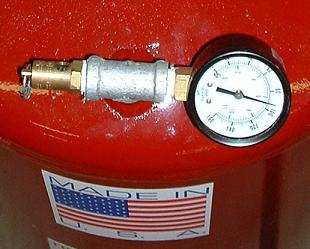
Safety Valve
Function: noun
1: a part in a machine that opens automatically to release steam, water, gas, etc., when pressure becomes too great
2: something that allows someone to release mental stress and tension in a harmless way
I get migraines. The first migraine I ever experienced was after a four-day road trip, driving from our previous home in San Diego, all the way across the country to Philadelphia. I was a Navy wife back then, and we had been transferred from the North Island NAS to the docks in Philadelphia for a refit. I'd driven 12 hours from some motel in Ohio, all the way across Pennsylvania, then threaded my way through Philadelphia, to a small bed and breakfast on the far side of Philly. The next day, we were scheduled to start looking for an apartment. That night, my first migraine developed, probabl a result of the pressures of moving into a new and unfamiliar city. All the pressures of coordinating the move, getting the car packed, moving the few animals we had back then, and lining up a new place to live, finally just boiled over. I spent most of that night trying to hold my skull together so it didn't fly into a million pieces. It was short lived, but some of the most intense pain I'd ever experienced.
My most recent migraine was today. I don't get them very often anymore, having learned over the last 20 years how diet, stress, sound, noise, motion and lack of sleep can all aggravate them. And how yoga, a healthy diet, a few days off and a readjustment of my work load or priorities will dramatically reduce my stress level. I've also learned how to stop what I'm doing at the first signs of an impending migraine, retreat into a "safe mode" of low light, low noise, easily digested foods and soothing music, where I try to ride it out without nearly as much discomfort as I had experienced the first time. Today, none of that stuff worked, and I was right back in the realm of pain that I first experienced back in Philly. As most folks who experience migraines can attest, pain medications don't generally work very well. Somehow the migraine goes above, below, around and through those pharmaceuticals. As a student of homeopathy, sometimes I have had success with using a homeopathic remedy to sooth both my skull and stomach. I have even heard home recipes for relief, which run from over-the-counter analgesics to a combination of chocolate, caffiene and aspirin. I can't think of a worse combination than those last three, so I haven't tried that combo yet. As one of my physicians commented, "sometimes you just need to go find some quiet place and be uncomfortable for awhile." Gee, thanks.
My migraine came and went. I lost most of the day in the process. I remember having a conversation on the phone with a regional sustainable ag group, and normally I would have really looked forward to that conversation. But today I barely got through it. Thirty seconds after I was off the phone, I was in bed wishing it was 12 hours later so the migraine would be done.
Migraines for me are a harsh reminder that sometimes we push too hard. We push schedules, work loads, healthy eating, stressful living, all for the sake of our perceived priorities. Sometimes those priorities are worthwhile. Many times, they're not. Ultimately, I think of migraines as something akin to a safety valve. When I have ignored my stress level long enough that pressures have built up, this is one guaranteed way to make me stop moving. And a guaranteed way to make me reconsider my workload, schedule, diet, and priorities. That re-assessment usually provides more sleep, better foods, fewer items on my immediate gotta-do list, and some quality time spent in relaxing surroundings. It is a reminder to me that these things are not luxuries. They are necessities.
Our society treats our bodies as if we were merely mechanical things. Symptoms of illness are merely physical issues to be treated with pharmaceuticals until we can get back on our feet again. Back to our old ways again. So our health issues move from short-term issues like migraine, into harder to treat issues like ulcers, back spasms, anxiety/depression, heart disease, cancer, and diabetes. We don't have to live like this. If migraines have taught me anything, they have taught me that my health is in my hands, and my choices have implications for my health. I am still learning to choose wisely. My farming life is full of stressors, gotta-do lists, high priorities, lofty goals and demanding schedules. But as with any profession, I must meet the demands of my calling with some demands of my own - time off, decent working conditions, breaks and mealtimes that actually provide nourishment for body and mind, and a livable wage such that I don't sweat every little item on the budget. It's a work in progress. Today I was reminded why that progress is just as important as any other goal we have here. Whatever your goals, Dear Reader, I hope you also take your mental and physical health into consideration. We can't do much to save the world in our own various ways, if we don't take good care of ourselves in the process.
Farm Outbuildings
February 6, 2011
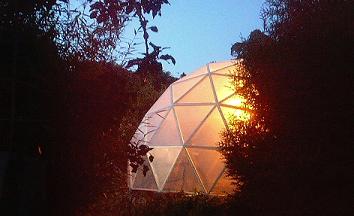
Outbuildings are to farming what spark plugs, fan belts and shock absorbers are to a car. They aren't what we usually think of when we consider the crops or animals we'd like to raise, but they are integral to our success (or failure) when raising them. And like the squeaky wheel that gets the grease, outbuildings often are knocked off our "gotta do" list until something goes wrong. Or we proactively put them front and center now, rather than waiting for something to break later.
Many current farming families, including us, started their operations on land which either had no outbuildings, or outbuildings in extremely poor repair. On our own place, the only structures we started with where the house itself, one very badly neglected 20x20 shed, and an old wellhouse. No barns, no fencing, no workshops. The shed was a generous size but it was open on one side to whatever the weather blew in, and the roof leaked badly. The ground was uneven inside, and the back cinder block wall was slowly but surely yielding to gravity's pull downhill. If we wanted protection for any of our equipment, supplies or animals, we'd have to build something new.
The first temptation is to put up something 'just for the short term'. That was certainly our first choice, since we weren't sure how sun and wind and weather moved across this particular landscape. There's an old tradition of living on the land for a year, if at all possible, before putting up anything permanent. That year's time brings a tremendous amount of valuble information about where the snow drifts during a storm, how the summer breezes roll down an eastern-facing hill, how storms tend to boil up from the southwest, and where the seasonal water table comes up when it rains a lot. An educated eye could predict some of that but there's nothing like time on the property to really get a feel for how it "works" through the year.
Unfortunately, temporary shelters tend to become permanent shelters as soon as we get busy with other things. We've had three "temporary" shelters up for five years' running, and they're starting to show their age. They have served as our poultry house, rabbit house, rodents house, and even a doghouse at one point. Given that we paid a pittance for them, and they were never rated for such long continuous use, they have done remarkably well. But the fabric is tearing, the supports are sagging and every new snowstorm or windstorm makes me cringe with thoughts that maybe this will be the storm that finally does them in. So each new storm, I find myself out there shoveling off roofs, stringing support lines, and doing whatever it takes to keep our "temporary" shelters up for one more round. And each time I swear to myself this will be the last time, because I'm going to replace them as soon as I can.
Replacement, however, is easier said than done. Temporary shelters are so popular because they're quick and they're inexpensive. That implies, correctly, that more permanent buildings are slower and more expensive to build. Construction materials must be heavier-duty, structural design must be more robust. Foundation and/or flooring must be able to take a lot of abuse and come back for more. Doors, windows and other openings must be easy and convenient to operate during all types of weather. Whatever roofing or siding or sheathing or film protectst the building, it must be chosen carefully to provide all the necessary coverage while also allowing whatever ventilation is required. There may also be local, county, state and federal code to be followed. Things like wind load, snow load, hurricane resistance and earthquake resistance may be a factor. If the new building can meet all these criteria, it can become an enormous asset to the farm. If the new building does not meet these criteria, it will only create more problems down the road.
An odd additional issue for us, and for some who are either too far or too inaccessible, is the issue of delivered components. Long ago we realized that our needs would by and large be well met by one or more commercial greenhouse structures. Yet upon checking into delivery options, we couldn't get them here because our access is so poor. Many of the common construction approaches today require the use of heavy and/or long delivery trucks to bring the concrete, the construction materials, and or the cranes to erect those materials. But for us, all our buildings would have to be delivered in nothing more than 20' increments, which ruled out most greenhouses. And a handful of other construction methods.
So our options have narrowed to a short but interesting list. At the top of that list is a type of geodesic quonset type structure, using the same general components as a geodesic dome but providing the shape of a greenhouse. It is composed of many small pieces, but is ultimately much, much stronger than almost anything else available. We will build a few of these structures and see how they work out, prior to endorsing them for anything other than some form of curious modern sculpture. But if they do work out, we'll be happy to share what we've come up with, and the existing stuctures which originally caught our interest. These structures will definitely look a lot more futuristic than the traditional barns we've come to know and love. But if they meet all our needs - structural, durability, cost and ease of assembly - we don't care what they look like. They'll have earned a place here. We'll keep you posted.
Farm Flexibility
February 5, 2011

I have been practicing yoga off and on for a number of years now. But lately I'd been lax in my practice - too many things to do, not enough time, and a general attitude of "I'll do it later." Well, this morning I was so stiff when I woke up I knew the time had come to get back into it. It's one thing to have occasional physical issues that don't really impact my ability to do the things that need doing. But when I have ongoing physical issues that reduce my effectiveness, that's a call to action.
Yoga itself isn't very difficult. Well, let me say it's not difficult to learn, but it takes a lifetime to master. I've heard people say they "aren't ready" for yoga; they have to train first, or study first, or any of a number of other plausible-sounding reasons to put off starting. Hogwash. Yoga is the ultimate "come as you are" party. No dress code. No minimum opening balance. No previous experience required. The only thing needed is a body, a pulse, and a willingness to explore some unfamiliar postures and sensations.
Like many really important things in life, someone watching yoga would have no idea what's really happening "behind the scenes". It is one of the few activities we can do together, which nevertheless takes us so deeply into our internal selves. Seemingly simple postures will suddenly bring new awareness of muscles, bones and tendons, along with tightness, resistance or discomfort, which we never knew was there. You'd think we'd each lived in our bodies long enough that we'd already know all that stuff. Nope. Like the day after doing hard physical labor shows you muscles you never knew you had, yoga introduces us to very new aspects of such fundamentals as breathing, movement and balance as we sit, as we walk, as we hold some limb in the air. And we are invited to go so deeply into our physical selves that sometimes we can lose track of our usual senses. I have occasionally been so immersed in a posture, with eyes closed and breathing deep, that the instructor will have to call me back to the world I forgot was out there. It's like taking a vacation without ever leaving home.
And what in the world does this have to do with farming? It is allegory, Dear Reader, and a useful metaphor for those moments when we find that our farms are stiff, painful, and/or unresponsive or restricted in some way. Just as yoga helps the individual body and mind move forward more nimbly, a yoga approach can help us find new ways for our farms to move and progress more comfortably. We often seek to get away from things that are pestering us - keep it at arm's length, put it on the back burner, shelf the idea or table the conversation. Our very language has all sorts of expressions for putting distance between us and something that bothers us. Yet yoga teaches us to go into the stiffness, into the discomfort, into those painful spots that are hampering our movements. Through such simple yoga tools as visualizing more space, breathing deeply through resistance and pressing gently but persistently into difficult postures, yoga helps us learn to move in ways we couldn't move before. And be more comfortable in the process. All those literals can be applied metaphorically to any and all aspects of farming (or life) that are causing us pain, or discomfort, or loss of mobility, or loss of function.
For instance, I used to dread hauling a hay bale into the goat yard every morning and evening, because I'd be mobbed by two dozen hungry animals that all weigh about as much (if not more) than I do. I'd put it off and chores would run late and then my whole schedule would be blown. Forcing my way through that mob every morning and evening wasn't earth shattering. But it was unpleasant. Yet the solution came to me one day while I was in one of my yoga postures. Instead of going into the yard to feed the goats, all I needed to do was set up feeders and aisles such that I always have a fence between me and them. Voila! A very simple modification, requiring less than half a day to set up, and suddenly I'd have no more resistance to forward movement, no sore spots that slowed me down, and a task I once dreaded could be done with ease in a relaxed manner. I made the change and goat feeding went from hassle to enjoyable. Not only did feeding get easier, I suddenly had a new ability to stand back and watch them all move around as they visited the new feeders and hay piles. Feeding time turned into a high quality herd assessment opportunity. As I look at how our farming practices have changed over the years, I can find similar instances of tasks which once were a real hassle, but which later were refined, and improved, and simplified thanks to yoga-like philosophy. Powerful movement, either physical or mental, became possible and even comfortable with little effort. That's what yoga gives us.
I think there's a danger in allowing ourselves to get so busy, so tired, and so sore (physically or mentally) that we don't give ourselves the chance to stand back and look at our day to day activities, and how to make them simpler or easier or more pleasant. Life is not "work hard and then you die". Life can be "work at what you love, and be a happy tired at the end of each day." It doesn't take more work. It takes looking at our daily tasks with new eyes, and breathing deeply into those unpleasant tasks to find more constructive ways to accomplish them. Whatever those tasks may be.
"What Should I Grow?"
February 4, 2011
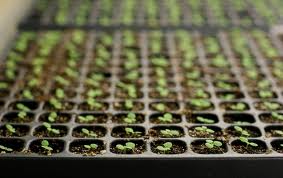
I got a delightfully enthusiastic email from one of my sustainable farming group email lists today. These groups are populated by a wide range of farming "types": those whose families have worked the same land for several generations, those who started off with their own piece of ground and have built vibrant farms over the passage of time, those who have only been on the land a few years and are still trying to work out the details, and those who are still in the city dreaming of their own piece of land. The email I speak of was from an individual who apparently had been in that last group for far too long, and had just made the break from city life to rural life. The subject line on his email went: "I just bought land! What can I grow?"
It is both a very simple, and very complex question. It is a question that all of us ask, and answer, repeatedly throughout our tenure on our various properties. It is a question communities ask when faced with the downturn of a traditional local crop that no longer commands good prices. It is a question whole societies and nations ask as their populations grow, their borders change, weather patterns shift and food/fiber/fodder needs change over time. Not to wax too metaphysical, but "What Can I Grow?" has been one of humanity's most fundamental questions since we first began to mull a life beyond being hunter-gatherers.
Yet it is also a very practical question, and it deserves treatment in the here and now rather than merely in the halls of Cultural Anthropology. Any given piece of ground has a population of plant, fungal, insect and animal life that it would support if left to its own devices. Even the most inhospitible real estate on Earth, whether naturally occuring or man-made, has been found to support life. Yet most of us aren't interested in becoming microbe farmers. So where do we start?
One good starting point is to instead ask "what do we want to grow?" That sounds flippant but it's not. If we have an image in our mind's eye of row after perfect row of green cornstalks, tassles glinting in the sun, we may not be very happy with a mushroom operation. Likewise if we love cool salad greens covered with dew as we harvest, we may not be interested in a greenhouse full of tomatoes on automatic watering systems. Before we sink a great deal of time, money, energy and effort into setting up a farm, we'd best figure out whether we'll be happy with it after it's built. There's nothing quite so discouraging as the time lost building something we don't fundamentally want.
That desire for growing X versus Y must be tempered, however, with an assessment of what our land can realistically produce. If I have my heart set on saguaro cactus farming, I'm living in the wrong part of the country up here in the Pacific Northwest given our cool damp climate. No matter what sorts of artificial growing environments I create, I'm simply not ever going to succeed with saguaro on anything other than a hobby basis. Yet if I moved to the right parts of the American Southwest, I woudn't have to work very hard to establish a fine saguaro ranch. By the same token, I love growing salad greens, and I'm in a very good part of the country for that. Our cool, damp, mild climate makes salad greens production possible throughout the year. And our close proximity to various population centers means I have a ready, willing and able marketplace to buy whatever I can raise. That's a recipe for success with just a relatively small amount of effort on my part.
A third consideration is the notion of "regulatory landscape". Regulatory oversight of many agricultural operations is a combination of federal, state and local ordinances. Some locations have a much heavier burden in that regard than others. I know of more than a few agricultural producers who were committed to bringing some new crop, value added food product, or refined livestock production to market. They knew they needed to work out the kinks before facing the additional burden of heavy regulatory oversight. So they deliberately moved their operations to locales where that regulatory oversight would be minimal. After they had worked out the kinks, they were able to provide a model for success to other areas which did have to live under those regulatory burdens. But since they had already worked out the details, those regulatory burdens were easier to live with. So in that context, sometimes we farmers still have to live with the law of "location, location, location".
This particular indivdual was relatively fortunate that his goals, and his parcel of land, were both flexible enough that he had a wide variety of options. After a variety of emails went back and forth on that group, he had a good list of potential crop ideas to go research. He also had learned what his area traditionally raises, and he know those crops would do well there. If I could pick a single crop that farmers everywhere would benefit from growing, it would be the Crop of Flexibility. If any given farmer is willing to explore at least two of these three: alternate crops, alternate markets, alternate locations - that farmer is well positioned to grow that most rewarding crop of all - Satisfaction.
Kick the Feed Bag Habit
February 3, 2011
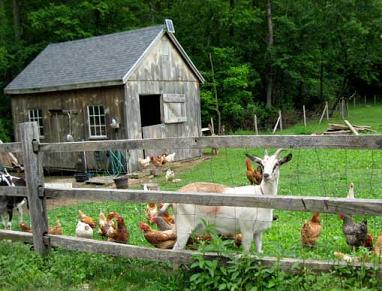
With the announcement of deregulated GE alfalfa spreading around the various livestock communities, many folks are wondering for the first time how they can go about raising their own feed. After all, the vast majority of small scale livestock owners have been working out of a feed bag for the past 50 years if not more. Yet that is not the norm for the bulk of small family farming history. It used to be very commonplace for folks to either raise their own feed on their own place, or partner with neighbors to raise feed in exchange for meat, dairy, eggs and other livestock products. If there is a silver lining to this whole GE nonsense, it would be that small scale producers are once again looking at how to provide their own feed.
But how? For most of us, our feed comes in only a few forms - baled hay, bagged silage or haylage, and a wide variety of pelleted combination diets with a myriad list of ingredients. Trying to figure out how to grow our own hay, create our own silage or haylage, or recreate those pelleted feeds can seem daunting. On the one hand, yes it is a complex business. On the other hand, we don't have to recreate those pellets, per se. We just have to recreate the proper ratio of nutrients within them.
Switching species and authors, Jerry Belanger devotes over 20 pages to the topic in Raising Milk Goats the Modern Way
For those who want a much more thorough immersion in the science of livestock nutrition, there's few better than Morrison's Feeds and Feeding: A Handbook for the Student and Stockman
A third "oldie but goodie" is the classic Small-Scale Grain Raising: An Organic Guide to Growing, Processing, and Using Nutritious Whole Grains for Home Gardeners and Local Farmers, 2nd Edition
If those books are old enough to make you squirm, and you're concerned you're missing out on new information, never fear. A variety of books have come out within the last 10-15 years about pastured livestock production, and incorporating traditional feedstocks into livestock rations to provide hay alternatives throughout the year. Joel Salatin has been instrumental in experimenting with, and writing up, pastured production for cattle, poultry, and rabbits. His books include You Can Farm: The Entrepreneur's Guide to Start & Succeed in a Farming Enterprise
Additionally, Jim Gerrish has a pair of books that should be in the hands of every ruminant owner in the country, along with any poultry producer or hog producer interested in pasturing their animals. His first book, Management-Intensive Grazing: The Grassroots of Grass Farming
So, Dear Reader, if you are concerned enough about GE crops that you want to grow your own, or perhaps you just want to see what's possible, there's plenty of information out there to get you started. How far you take it, and how much of your own feed you end up raising for yourself, is up to you. If nothing else, these sources of information would help you reach out to nearby producers that you can partner with. That can also be a potent combination, because you'd get the feeds you need, raised in ways you approve of, for far less than retail. And nearby growers are often delighted to work with clients who know what they want and will buy in bulk every year. Even if you don’t care about GE alfalfa, I heartily encourage you to explore some of these options. We don't need to live out of the retail feed bag. We never really did. And now the documentation is better than ever on how to raise our own feeds. To quote one of my favorite poetic passages, I encourage you "to strive, to seek, to find, and not to yield", in your efforts to secure wholesome non-GE foods and feeds. It can be done.
Seeds of Destruction, Seeds of Hope
February 2, 2011
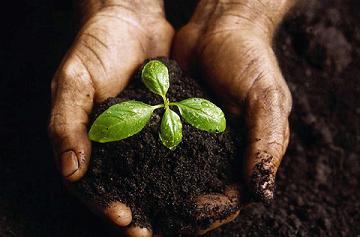
The news broke here like it broke everywhere, as a minor news headline which took awhile to sink in. Genetically engineered alfalfa varieties had been given the official federal OK to be planted anywhere, anytime, by anyone who wants to buy the seed from Monsanto, as of this coming spring. That deregulation occured despite strong public pressure against it. And it was accompanied by no labeling requirements whatsoever, despite the fact that many consumers here, and many of our export partners, strongly object to its use.
It felt like a kick to the gut. And to the head.
Genetic engineering is a mixed blessing. I say that because at best, it can provide some helpful new genetic traits in valuable food crops which cannot be provided otherwise. However, the technique is far from being the precision instrument it is portrayed as being. We do not yet have the ability to "cut and paste" exactly the genetic material we want to move from one plant into another. There are always additional genetic materials that come along for the ride, which have their own
sometimes unexpected impacts on the recipient plant. Additionally, we have learned that any single genetic pair may be involved with more than one trait. Even as we introduce the traits we wanted, we can simultaneously introduce unexpected new traits. At worst, it's a Pandora's box of unknown unintentional consequences. We have already seen instances of genetic drift not only to unintended nearby crops, but also to closely related weeds. We have also seen a variety of health issues or reactions to GE crops, ranging from livestock and wildlife who will not eat GE crops, all the way to human beings eating GE materials without knowing they've done so, and then suffering allergic reactions to the new genetic materials and the chemical substances they created. The problems with GE crops are not merely theoretical.
Going through all the repercussions here would take much, much more space than I generally devote to daily blogs. Nevertheless, I wanted to provide you, Dear Reader, with some online resources to help you sort out the various issues involved with genetic engineering in general, and the repercussions of deregulated genetically engineered alfalfa in particular.
NOTE: I have tried to provide information not from activist and alternative news sources, per se, but from those parties who have either extensive experience in genetic engineering and/or agricultural production, and are in a position to be held responsible for the accuracy of their statements, by their peers and colleagues. As a result, these various sources will have different interpretations of genetic engineering, but they should all be technically accurate. I make that distinction because many activist and alternative news websites merely parrot what they read elsewhere, without having any fundamental working knowledge of the methods in use, and without any repercussions from providing blatantly incorrect information. As always, Reader Beware, of not only the information provided, but also the source.
* introduction to genetic engineering, and its pro's and con's:
West Virginia University's Extension Service GE Pro's/Con's
West Virginia University's GE Pro's/Con's, Part II
Sustainable Table's Issues Page on Genetic Engineering
Human Genome Project Information's GE Issues page
National Sustainable Agriculture Information Service's Organic Crop Issues page, including comments on GE
Maize cDNA Project's GE Issues page
* the formal announcement of the USDA's deregulation of GE alfalfa:
Federal Register February 2, 2011
* why GE alfalfa is such a huge problem:
Environmental News Service Article
Ecological Farming Association's GE Alfalfa Information Page
National Sustainable Agriculture Coalition's GE Alfalfa page
Associated Press' article about GE Alfalfa contamination
A lengthier look at the implications of genetically engineered alfalfa is available here. This will open as a PDF document:
Western Organization of Resource Council's position paper on GE Alfalfa
Whenever some big new development rolls into our individual or collective realities, we have a choice. We can:
* refuse to believe it
* accept it with resignation and silence
* rant and rave and shout and stamp our feet but not actually DO anything useful
* change our methods, our goals, and/or our strategies to get through, get around, and get past new challenges
In the context of this latest major setback to sustainable agriculture, a number of people, including us, have decided to move forward with plans that until now had only been on the drawing boards. Now, those plans are being dusted off and reviewed to see how well they might help answer this new development, either for our own operations and/or for our customers and communities. Some of these new plans include:
* raising our own feed so that we can control what seeds we use, how it is produced, and what our animals eat
* setting up a fraction of each crop such that we can save viable, genetically-pure seed from generation to generation, in
ways that minimize or eliminate the potential for GE contamination
* making that seed available to others, either via informal Seed Savers exchanges amongst groups, and/or via seed sales (again either locally, regionally or nationally).
* getting more involved in local, national and international attempts to save not only domesticated seed varieties, but also
wild relatives of our domesticated species, via participation with seed banks, biodiversity efforts, and sustainable farming
organizations.
We heartily encourage others to pursue any or all of the above options, as they fit into individual operations.
To learn more about how you can fight this issue, check out these online resources:
* join efforts to petition President Obama to overturn this decision:
Petition to President Obama
*Join local, national and international seed saving efforts:
Seed Savers Exchange
International Seed Saving Institute
Native Seeds of the American Southwest
Seeds Trust
Baker Creek Heirloom Seeds
* Learn how to save your own garden's seeds:
How to Save Garden Seeds website
Mother Earth News Article on How to Save Seeds
Seed Saving for Beginners
Seed to Seed: Seed Saving and Growing Techniques for Vegetable Gardeners, 2nd Edition
The New Seed-Starter's Handbook
Breed Your Own Vegetable Varieties: The Gardener's and Farmer's Guide to Plant Breeding and Seed Saving, 2nd Edition
Seed Sowing and Saving: Step-by-Step Techniques for Collecting and Growing More Than 100 Vegetables, Flowers, and Herbs (Gardening Skills Illustrated)
If you, Dear Reader, taking nothing else from this blog, please take these thoughts to heart:
Every adversity, every failure, and every heartache, carries with it the Seed of an equivalent or greater Benefit.
Napolean Hill
Earth teach me to forget myself as melted snow forgets its life.
Earth teach me resignation as the leaves which die in the
fall.
Earth teach me courage as the tree which stands all alone.
Earth teach me regeneration as the seed which rises in the
spring.
William Alexander
Whether you tend a garden or not, you are the gardener of your own being, the seed of your destiny.
The Findhorn Community
Don't judge each day by the harvest you reap, but by the seeds you plant.
Robert Louis Stevenson
All the flowers of all the tomorrows are in the seeds of today.
Author Unknown
Now seeds are just dimes to the man in the store
And the dimes are the things that he needs,
And I've been to buy them in seasons before
But have thought of them merely as seeds;
But it flashed through my mind as I took them this time,
"You purchased a miracle here for a dime."
Edgar A. Guest, A Package of Seeds
Now, Dear Reader, go forth and PLANT SOMETHING!
A Farm's Most Important Asset
February 1, 2011
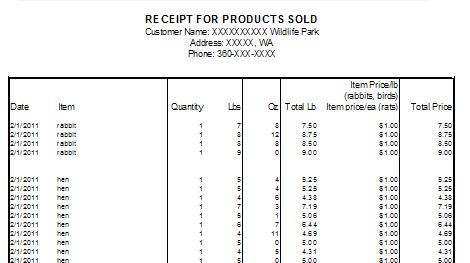
Today I spent most of the day traveling to, and then from, a critical place in the grand scheme of things. In our scheme of things anyway. Where on earth did I go? To deliver a truckload of product to a customer.
Most folks don't get into farming with their customers in mind. We get into farming for all sorts of other reasons - we love plants, we love animals, we love the outdoors, our family has farmed for however many generations, or some combination. We spend our days figuring out how to grow our crops better, how to raise healthier animals, how to preserve and protect the landscapes we work in. How to preserve and protect the buildings we work in. How to respond to, and anticipate, the various elements that will affect our operation - the weather, the politics, the economy, the social changes in which we exist.
But you'll notice that the word "customer" isn't in that description. Yet customers are the fuel that drive this engine called a farm. Without customers, we very quickly lose the ability, and sometimes the motivation, to move forward.
Customers are an odd bird. To quote a favorite TV show, "don't brand the cattle. Brand the customer. They're the ones most likely to wander away." Customers are often regarded as this unknown creature that occassionally stares at us from the periphery of the farm. Sometimes they dare to set foot on the farm and make demands. Sometimes they call, or email, with questions which can range from profound to inane. Sometimes they'll show up at the farm gate at 7am on a Sunday morning and wonder why we aren't open for business. Sometimes they'll call at 10:50pm the night before a delivery, and ask if we can tack on another six items to their order, "just this once". I have occassionally heard it said that farming would be a lot more fun without customers.
Then there are the customers that send you a Happy Birthday card and you have no idea how they found out it was your birthday. They show up the day after a flood and ask if they can help you clean up. They mail you a check to buy replacement stock when fire takes your barn and most of your animals. At market, they bring their moms, their kids, their best friends and introduce you as THE farmer they buy their food from, as if we were royalty. And they buy that last tomato, the one that everyone else passed up, because they wanted to make sure they got your tomatoes instead of going home without.
This particular customer has been fantastic to work with, and to be honest we gave them a lot of opportunity to wander away. They wanted to buy meat animals from us, but it was crucial to them that the animals not only were raised well, but also dispatched well. It was important to them that we were local, sustainable, humane, and amenable to new ideas and new products. I can't count how many times we gave them a good reason to abandon us, when I was slow to return their calls, or when I was sold out and couldn't sell them as much as they'd wanted, or when our production hiccups meant I didn't have anything to sell at all. They kept trying. And we kept trying. And somehow, somewhere along the line, we became partners in this attempt to make the world a better place. Every time I work with them, I think "my goodness, I don't know why they stayed with us but thank God they did."
I think there are a lot of things to keep track of when running a farm. But perhaps one of the most critical is to ensure we tend to our customers as carefully as we tend to any of our plantings or animals. Without our customers, we can't survive. And there's other places our customers can buy what they need. They should be treated like gold because that's exactly what they're worth. Thank God for good customers, because they allow me to keep doing what I love doing.
Our Successful Farming and Ranching Books
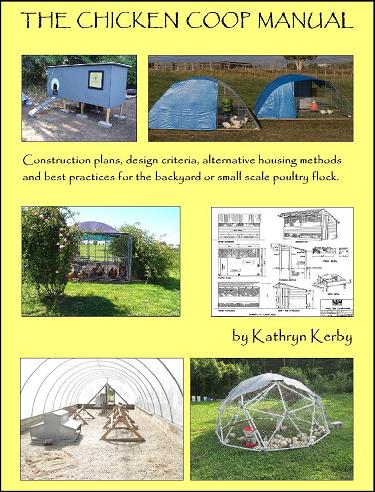
We released our very first self-published book. The Chicken Coop Manual in 2014. It is a full color guide to conventional and alternative poultry housing options, including 8 conventional stud construction plans, 12 alternative housing methods, and almost 20 different design features. This book is available on Amazon.com and as a PDF download. Please visit The Chicken Coop Manual page for more information.
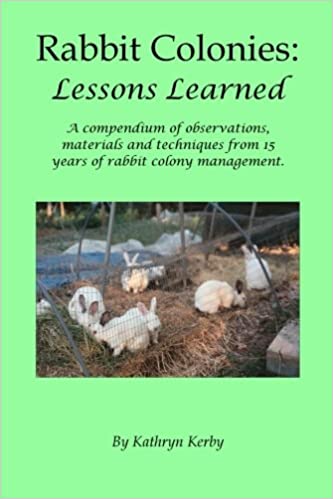
Rabbit Colonies: Lessons Learned
We started with rabbits in 2002, and we've been experimenting with colony management ever since. Fast forward to 2017, when I decided to write another book, this time about colony management. The book is chock-full of practical information, and is available from both Amazon and as a PDF download. Please visit the Rabbit Colonies page for more information.
The Pastured Pig Handbook
We are currently working on our next self-published book: The Pastured Pig Handbook. This particular book addresses a profitable, popular and successful hog management approach which sadly is not yet well documented. Our handbook, will cover all the various issues involved with pastured hog management, including case studies of numerous current pastured pig operations. If you have any questions about this book, please Contact Us.

Weblog Archives
We published a farm blog between January 2011 and April 2012. We reluctantly ceased writing them due to time constraints, and we hope to begin writing them again someday. In the meantime, we offer a Weblog Archive so that readers can access past blog articles at any time.
If and when we return to writing blogs, we'll post that news here. Until then, happy reading!




